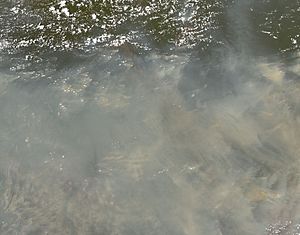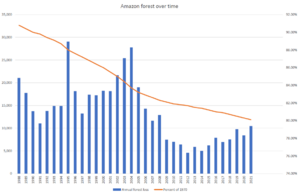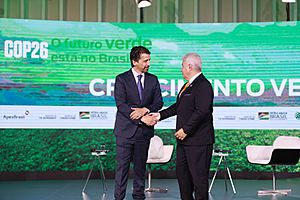Deforestation of the Amazon rainforest facts for kids
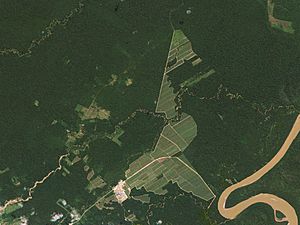
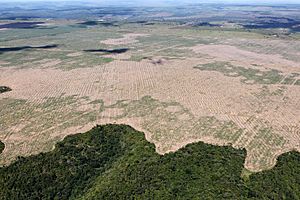
The Amazon rainforest, spanning an area of 3,000,000 km2 (1,200,000 sq mi), is recognized as the largest rainforest globally. It encompasses the largest and most biodiverse tract of tropical rainforest in the world, representing over half of the planet's rainforests. The Amazon region includes territories of nine nations, with Brazil containing the majority (50%), followed by Peru (13%), Colombia (10%), and smaller portions in Venezuela, Ecuador, Bolivia, Guyana, Suriname, and French Guiana.
Cattle ranching in the Brazilian Amazon has been identified as the primary cause of deforestation, accounting for about 80% of all deforestation in the region. This makes it the world's largest single driver of deforestation, contributing to approximately 14% of the global annual deforestation. Government tax revenue has subsidized much of the agricultural activity that leads to deforestation. By 1995, 70% of previously forested land in the Amazon and 91% of land deforested since 1970 had been converted for cattle ranching. The remaining deforestation primarily results from small-scale subsistence agriculture and mechanized cropland producing crops like soy, palm, and others.
Over one-third of the Amazon rainforest is designated as formally acknowledged indigenous territory, amounting to more than 3,344 territories. Historically, indigenous Amazonian peoples have relied on the forest for various needs such as food, shelter, water, fiber, fuel, and medicines. The forest holds significant cultural and cosmological importance for them. Despite external pressures, deforestation rates are comparatively lower within indigenous territories.
Satellite data from 2018 revealed a decade-high rate of deforestation in the Amazon, with approximately 7,900 km2 (3,100 sq mi) destroyed between August 2017 and July 2018. The states of Mato Grosso and Pará experienced the highest levels of deforestation during this period. Illegal logging was cited as a cause by the Brazilian environment minister, while critics highlighted the expansion of agriculture as a factor encroaching on the rainforest. Researchers warn that the forest may reach a tipping point where it cannot generate sufficient rainfall to sustain itself. Recent reports indicate a 22% increase in deforestation from the previous year, reaching the highest level since 2006.
In the pre-Columbian era, certain parts of the Amazon rainforest were densely populated and cultivated. However, European colonization in the 16th century, driven by the pursuit of gold and later the rubber boom, depopulated the region due to diseases and slavery, leading to forest regrowth.
Until the 1970s, access to the largely roadless interior of the forest was challenging, and it remained mostly intact apart from partial clearing along rivers. Deforestation escalated after the construction of highways penetrating deep into the forest, such as the Trans-Amazonian Highway in 1972.
Challenges arose in parts of the Amazon where poor soil conditions made plantation-based agriculture unprofitable. The crucial turning point in deforestation occurred when colonists began establishing farms within the forest during the 1960s. Their farming practices relied on crop cultivation and the slash-and-burn method. However, due to soil fertility loss and weed invasion, the colonists struggled to effectively manage their fields and crops.
Indigenous areas in the Peruvian Amazon, like the Urarina's Chambira River Basin, experience limited soil productivity, leading to the continual clearing of new lands by indigenous horticulturalists. Cattle raising dominated Amazonian colonization as it required less labor, generated decent profits, and involved land under state ownership. While promoted as a reforestation measure, the privatization of land was criticized for potentially encouraging further deforestation and disregarding the rights of Peru's indigenous people, who typically lack formal land titles. The associated law, known as Law 840, faced significant resistance and was eventually repealed for being unconstitutional.
Illegal deforestation in the Amazon increased in 2015 after decades of decline, driven primarily by consumer demand for products like palm oil. Brazilian farmers clear land to accommodate the growing demand for crops such as palm oil and soy. Deforestation releases significant amounts of carbon, and if current levels continue, the remaining forests worldwide could disappear within 100 years. The Brazilian government implemented the RED (reducing emissions from deforestation and forest degradation) program to combat deforestation, providing support to various African countries through education programs and financial contributions.
Since January 2019, Brazil's president, Jair Bolsonaro, has issued an executive order granting the agriculture ministry oversight of certain Amazon lands. This decision has been supported by cattle ranchers and mining companies but criticized for endangering indigenous populations and contributing to climate change, thereby increasing Brazil's relative contribution to global climate change.
Contents
Causes of deforestation
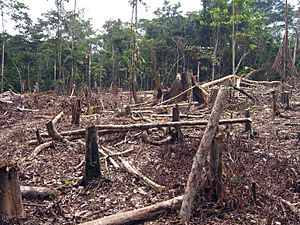
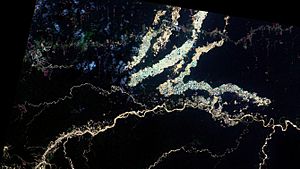
The deforestation of the Amazon rainforest is influenced by various factors at local, national, and international levels. The rainforest is sought after for purposes such as cattle ranching, the extraction of valuable hardwoods, land for housing and farming (especially soybeans), the construction of roads (including highways and smaller roads), and the collection of medicinal resources. Deforestation in Brazil is also linked to an economic growth model focused on accumulating factors, primarily land, rather than enhancing overall productivity. It's important to note that illegal logging is a common practice in tree removal during deforestation.
Cattle ranching
According to a 2004 World Bank paper and a 2009 Greenpeace report, cattle ranching in the Brazilian Amazon, supported by the international beef and leather trades, has been identified as responsible for approximately 80% of deforestation in the region. This accounts for about 14% of the world's total annual deforestation, making it the largest driver of deforestation globally. The Food and Agriculture Organization of the United Nations reported in 2006 that 70% of previously forested land in the Amazon, as well as 91% of land deforested since 1970, is now used for livestock pasture. The 2019 European Union-Mercosur Free Trade Agreement, which establishes one of the world's largest free trade areas, has faced criticism from environmental activists and advocates for indigenous rights. They argue that the trade agreement will contribute to further deforestation of the Amazon rainforest by expanding market access for Brazilian beef.
During Jair Bolsonaro's government, certain environmental laws were weakened, accompanied by reductions in funding and personnel in key government agencies and the dismissal of agency heads and state bodies. The deforestation of the Amazon rainforest accelerated during the COVID-19 pandemic in Brazil. According to Brazil's National Institute for Space Research (INPE), deforestation in the Brazilian Amazon increased by more than 50% in the first three months of 2020 compared to the same period in 2019.
Soy bean
Deforestation in the Amazon has occurred as a result of farmers clearing land for mechanized cropland. A study based on NASA satellite data in 2006 revealed that the clearing of land for mechanized cropland had become a significant factor in deforestation in the Brazilian Amazon. This change in land use has had an impact on the region's climate. Researchers discovered that in 2004, a peak year for deforestation, over 20% of the forests in the state of Mato Grosso were converted to cropland. In 2005, when soybean prices decreased by more than 25%, certain areas of Mato Grosso showed a decline in large-scale deforestation events, suggesting that price fluctuations of other crops, beef, and timber could also have a notable influence on future land use in the region.
The cultivation of soybeans, primarily for export and the production of biodiesel and animal feed, has been a significant driver of forest loss in the Amazon. As soybean prices have risen, soy farmers have expanded their activities into forested areas of the Amazon. However, the implementation of a private sector agreement known as the Soy Moratorium has played a crucial role in significantly reducing deforestation associated with soy production in the region. In 2006, several major commodity trading companies, including Cargill, pledged not to purchase soybeans produced in recently deforested areas of the Brazilian Amazon. Prior to the moratorium, 30% of soy field expansion was linked to deforestation, contributing to record-high deforestation rates. After eight years of the moratorium, a study conducted in 2015 found that although the soy production area had expanded by 1.3 million hectares, only about 1% of the new soy expansion had occurred at the expense of forests. In response to the moratorium, farmers opted to plant crops on already cleared land.
The perceived needs of soy farmers have been used to justify certain controversial transportation projects that have been developed in the Amazon. The Belém-Brasília highway (1958) and the Cuiabá-Porto Velho highway (1968) were the only federal highways in the Legal Amazon region that were paved and accessible year-round before the late 1990s. These two highways are considered to be central to the "arc of deforestation," which is presently the primary area of deforestation in the Brazilian Amazon. The Belém-Brasília highway attracted nearly two million settlers in its first twenty years. The success of this highway in opening up the forest was replicated as additional paved roads were constructed, leading to an unstoppable wave of settlement. The completion of these roads was followed by a significant influx of settlers, who also had a substantial impact on the forest.
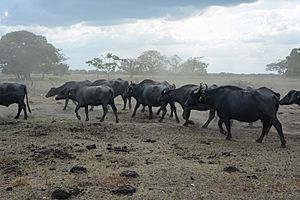
Logging
Logging in deforestation refers to the practice of cutting down trees for commercial purposes, primarily for the timber industry, which contributes to the overall deforestation of an area. Deforestation is the permanent removal of forests and vegetation cover from an area, often resulting in ecological, social, and economic impacts.
The logging process typically involves the following steps:
- Tree selection: Loggers identify and select specific trees for harvesting based on their species, size, and commercial value. Valuable tree species often targeted for logging include mahogany, teak, oak, and other hardwoods.
- Access and infrastructure development: Loggers establish infrastructure such as roads and trails within the forest to reach the targeted trees. This infrastructure facilitates the transportation of heavy machinery, logging equipment, and harvested timber.
- Clearing vegetation: Prior to logging, loggers often clear the understory vegetation and smaller trees surrounding the target trees to enhance access and maneuverability for machinery.
- Tree felling: The selected trees are cut down using chainsaws, harvesters, or other mechanized equipment. The felled trees are then prepared for further processing.
- Timber extraction: Once the trees are felled, loggers extract the timber from the forest by removing branches and cutting the tree trunks into logs of appropriate sizes for transport.
- Log transportation: Extracted logs are transported from the logging site to processing facilities or storage areas using trucks, barges, or helicopters, depending on the accessibility of the area.
- Processing and utilization: At processing facilities, the harvested logs are further processed into lumber, plywood, or other wood products. These products find applications in various industries, such as construction, furniture manufacturing, or paper production.
The impacts of logging on deforestation are significant and wide-ranging.
- Loss of biodiversity: Logging often leads to the destruction of forest ecosystems, resulting in the loss of habitat for numerous plant and animal species. Deforestation disrupts the intricate web of biodiversity and can contribute to the extinction or endangerment of various species.
- Carbon emissions and climate change: Trees play a crucial role in mitigating climate change by absorbing carbon dioxide through photosynthesis. When trees are logged, the stored carbon is released back into the atmosphere as carbon dioxide, contributing to greenhouse gas emissions and climate change.
- Soil erosion and degradation: Forests provide a protective cover for the soil, preventing erosion by wind and water. The removal of trees makes the exposed soil more vulnerable to erosion, leading to the loss of fertile topsoil and the degradation of the land.
- Disruption of water cycles: Forests act as natural water catchments, regulating water flow and maintaining water quality. Deforestation can disrupt the water cycle, resulting in reduced water availability, altered rainfall patterns, and an increased risk of droughts or floods.
- Indigenous and local community impacts: Many indigenous peoples and local communities depend on forests for their livelihoods, cultural practices, and sustenance. Deforestation and logging can displace these communities, undermine their traditional way of life, and create social conflicts.
- Economic considerations: While logging can provide economic benefits in terms of employment and revenue generation, unsustainable logging practices can deplete forest resources and undermine long-term economic sustainability. Overexploitation of forests can lead to the loss of potential future income and economic opportunities.
Efforts to address the impacts of logging on deforestation include implementing sustainable forest management practices, promoting reforestation and afforestation, establishing protected areas, enforcing regulations and policies, and supporting alternative livelihood options for local communities dependent on forests.
A 2013 paper found a correlation between rainforest logging in the Amazon and reduced precipitation in the area, resulting in lower yields per hectare. This suggests that, on a broader scale, there is no economic gain for Brazil through logging, selling trees, and using the cleared land for pastoral purposes.
Crude oil
According to a September 2016 report by Amazon Watch, the importation of crude oil by the US is linked to about 20,000 sq mi (~50,000 km2) of rainforest destruction in the Amazon and the emission of substantial greenhouse gases. These impacts are mostly focused in the western Amazon countries of Ecuador, Peru, and Colombia. The report also indicates that oil exploration is occuring in an additional ~100,000 sq mi (~250,000 km2) of rainforest.
Other
During August 2019, a prolonged forest fire occurred in the Amazon, contributing significantly to deforestation during that summer. Approximately 519 sq mi (1,340 km2) of the Amazon forest was lost. It is worth noting that certain instances of deforestation in the Amazon have been attributed to farmers clearing land for small-scale subsistence agriculture.
Loss rates
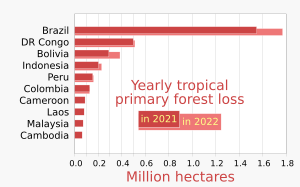
During the early 2000s, deforestation in the Amazon rainforest showed an increasing trend, with an annual rate of 27,423 km2 (10,588 sq mi) of forest loss recorded in 2004. Subsequently, the annual rate of forest loss generally slowed between 2004 and 2012, although there were spikes in deforestation rates in 2008, 2013, and 2015.
However, recent data suggests that the loss of forest cover is once again accelerating. Between August 2017 and July 2018, approximately 7,900 km2 (3,100 sq mi) of forest were deforested in Brazil, representing a 13.7% increase compared to the previous year and the largest area cleared since 2008. Deforestation in the Brazilian Amazon rainforest experienced a significant surge in June 2019, rising more than 88% compared to the same month in 2018. and more than doubling in January 2020 compared to January 2019.
In August 2019, a substantial number of forest fires, totaling 30,901 individual fires, were reported, marking a threefold increase compared to the previous year. However, the number of fires decreased by one-third in September, and by October 7, it had dropped to approximately 10,000. It is important to note that deforestation is considered to have more severe consequences than burning. The National Institute for Space Research (INPE) in Brazil estimated that at least 7,747 km2 (2,991 sq mi) of the Brazilian Amazon rainforest were cleared during the first half of 2019. INPE subsequently reported that deforestation in the Brazilian Amazon reached a 12-year high between August 2019 and July 2020.
Deforestation figures in Brazil are annually provided by the Instituto Nacional de Pesquisas Espaciais (INPE), based on satellite images captured during the dry season in the Amazon by the Landsat satellite. It's important to note that these estimates may focus solely on the loss of the Amazon rainforest and may not include the loss of natural fields or savannah within the Amazon biome.
Estimated loss by year
| Period | Estimated remaining forest cover in the Brazilian Amazon (km2) |
Annual forest loss (km2) |
Percent of 1970 cover remaining |
Total forest loss (km2) |
|---|---|---|---|---|
| Pre–1970 | 4,100,001 | — | — | — |
| 1977 | 3,955,870 | 21,130 | 96.5% | 144,130 |
| 1978–1987 | 3,744,570 | 211,300 | 91.3% | 355,430 |
| 1988 | 3,723,520 | 21,050 | 90.8% | 376,480 |
| 1989 | 3,705,750 | 17,770 | 90.4% | 394,250 |
| 1990 | 3,692,020 | 13,730 | 90.0% | 407,980 |
| 1991 | 3,680,990 | 11,030 | 89.8% | 419,010 |
| 1992 | 3,667,204 | 13,786 | 89.4% | 432,796 |
| 1993 | 3,652,308 | 14,896 | 89.1% | 447,692 |
| 1994 | 3,637,412 | 14,896 | 88.7% | 462,588 |
| 1995 | 3,608,353 | 29,059 | 88.0% | 491,647 |
| 1996 | 3,590,192 | 18,161 | 87.6% | 509,808 |
| 1997 | 3,576,965 | 13,227 | 87.2% | 523,035 |
| 1998 | 3,559,582 | 17,383 | 86.8% | 540,418 |
| 1999 | 3,542,323 | 17,259 | 86.4% | 557,677 |
| 2000 | 3,524,097 | 18,226 | 86.0% | 575,903 |
| 2001 | 3,505,932 | 18,165 | 85.5% | 594,068 |
| 2002 | 3,484,281 | 21,651 | 85.0% | 615,719 |
| 2003 | 3,458,885 | 25,396 | 84.4% | 641,115 |
| 2004 | 3,431,113 | 27,772 | 83.7% | 668,887 |
| 2005 | 3,412,099 | 19,014 | 83.2% | 687,901 |
| 2006 | 3,397,814 | 14,285 | 82.9% | 702,186 |
| 2007 | 3,386,163 | 11,651 | 82.6% | 713,837 |
| 2008 | 3,373,252 | 12,911 | 82.3% | 726,748 |
| 2009 | 3,365,788 | 7,464 | 82.1% | 734,212 |
| 2010 | 3,358,788 | 7,000 | 81.9% | 741,212 |
| 2011 | 3,352,370 | 6,418 | 81.8% | 747,630 |
| 2012 | 3,347,799 | 4,571 | 81.7% | 752,201 |
| 2013 | 3,341,908 | 5,891 | 81.5% | 758,092 |
| 2014 | 3,336,896 | 5,012 | 81.4% | 763,104 |
| 2015 | 3,330,689 | 6,207 | 81.2% | 769,311 |
| 2016 | 3,322,796 | 7,893 | 81.0% | 777,204 |
| 2017 | 3,315,849 | 6,947 | 80.9% | 784,151 |
| 2018 | 3,308,313 | 7,536 | 80.7% | 791,687 |
| 2019 | 3,298,551 | 9,762 | 80.5% | 801,449 |
| 2020 | 3,290,125† | 8,426 | 80.2% | 809,875 |
| 2021 | 3,279,649 | 10,476 | 80.0% | 820,351 |
| 2022 | 3,268,049 | 11,600 | 79.7% | 831,951 |
†Value calculated from estimated forest loss, not directly known.
Impacts
Deforestation and biodiversity loss in the Amazon rainforest have resulted in significant risks of irreversible changes. Modeling studies have suggested that deforestation may be approaching a critical "tipping point" where large-scale "savannization" or desertification could occur, leading to catastrophic consequences for the global climate. This tipping point could trigger a self-perpetuating collapse of biodiversity and ecosystems in the region. Failing to prevent this tipping point could have severe impacts on the economy, natural capital, and ecosystem services. A study published in Nature Climate Change in 2022 provided empirical evidence that more than three-quarters of the Amazon rainforest has experienced a decline in resilience since the early 2000s, posing risks of dieback that would impact biodiversity, carbon storage, and climate change.
To maintain a high level of biodiversity, research suggests that a threshold of 40% forest cover in the Amazon should be maintained.
Impact on global warming
Deforestation, along with other forms of ecosystem destruction such as peatbog degradation, can have multiple effects. It can reduce the carbon sink capacity of the land and contribute to increased emissions through factors like wildfires, land-use change, and reduced ecosystem health. These impacts can disrupt the normal carbon-absorbing processes of ecosystems, leading to stress and imbalance.
Historically, the Amazon Basin has played a significant role as a carbon sink, absorbing approximately 25% of the carbon captured by terrestrial land.
However, a scientific review article published in 2021 indicates that current evidence suggests the Amazon basin is currently emitting more greenhouse gases than it absorbs overall. This shift is attributed to climate change impacts and human activities in the region, particularly wildfires, current land-use practices, and deforestation. These factors contribute to the release of forcing agents that are likely to result in a net warming effect. Warming temperatures and changing weather patterns also lead to physiological responses in the forest, further hindering the absorption of CO2.
Impacts on water supply
The deforestation of the Amazon rainforest has had a significant impact on Brazil's freshwater supply, particularly affecting the agricultural industry, which has been involved in clearing the forests. In 2005, certain regions of the Amazon basin experienced the most severe drought in over a century. This can be attributed to two key factors:
1. The rainforest plays a crucial role in contributing to rainfall across Brazil, even in distant areas. Deforestation has exacerbated the effects of droughts in 2005, 2010, and 2015–2016.
2. The rainforest contributes to rainfall and facilitates water storage, which in turn provides freshwater to the rivers that supply Brazil and other countries with water.
Impact on local temperature
In 2019, a group of scientists conducted research indicating that under a "business as usual" scenario, the deforestation of the Amazon rainforest will lead to a temperature increase of 1.45 degrees in Brazil. They stated that this temperature rise could have various consequences, including increased human mortality rates and electricity demands, reduced agricultural yields and water resources, and the potential collapse of biodiversity, especially in tropical regions. Additionally, local warming may cause shifts in species distributions, including those involved in the transmission of infectious disease. The authors of the paper assert that deforestation is already contributing to the observed temperature rise.
Impact on indigenous people

More than one-third of the Amazon forest is designated as Indigenous territory, encompassing over 4,466 formally recognized territories. Until 2015, approximately 8% of deforestation in the Amazon occurred within forests inhabited by indigenous peoples, while 88% occurred in areas outside of indigenous territories and protected areas, despite these areas comprising less than 50% of the total Amazon region. Indigenous communities have historically relied on the forest for sustenance, shelter, water, materials, fuel, and medicinal resources. The forest holds significant cultural and spiritual importance for them. Consequently, deforestation rates tend to be lower within Indigenous Territories, even though pressures to clear land for other purposes persist.
During the deforestation of the Amazon, native tribes have often faced mistreatment and abuse. Encroachments by loggers onto indigenous lands have led to conflicts resulting in fatalities. Some uncontacted indigenous groups have emerged from the forests and interacted with mainstream society due to threats from outsiders. When uncontacted tribes come into contact with outsiders, they are vulnerable to diseases against which they have little immunity. As a result, entire tribes can be severely impacted by epidemics, leading to significant population declines within a few years.
A long-standing struggle has taken place over the control of indigenous territories in the Amazon, primarily involving the Brazilian government. The demand for these lands has stemmed, in part, from the aim of enhancing Brazil's economic standing. Various individuals, including ranchers and land speculators from the southeast, have sought to claim these lands for personal financial gain. In early 2019, Brazil's newly elected president, Jair Bolsonaro, issued an executive order empowering the agriculture ministry to regulate the land occupied by indigenous tribes in the Amazon.
In the past, mining operations were permitted within the territory of an isolated indigenous group called the Yanomami. The conditions endured by these indigenous peoples resulted in many health issues, including tuberculosis. If their lands are utilized for further development, numerous tribal communities will be forcibly displaced, potentially leading to the loss of lives. In addition to the mistreatment of indigenous peoples, the exploitation of the forest itself will result in the depletion of vital resources necessary for their daily lives.
Future of the Amazon rainforest
Based on the deforestation rates observed in 2005, projections indicated that the Amazon rainforest would experience a 40% reduction within two decades. While the rate of deforestation has slowed since the early 2000s, the forest continues to shrink annually, and satellite data analysis reveals a significant increase in deforestation since 2018.
Norwegian Prime Minister Jens Stoltenberg announced on September 16, 2008, that the Norwegian government would contribute a donation of US$1 billion to the newly established Amazon Fund. The funds from this initiative would be allocated to projects aimed at mitigating the deforestation of the Amazon rainforest.
In September 2015, Brazilian President Dilma Rousseff addressed the United Nations, reporting that Brazil had effectively reduced the deforestation rate in the Amazon by 82%. She also outlined Brazil's goals for the next 15 years, which included eliminating illegal deforestation, restoring and reforesting an area of 120,000 km2 (46,000 sq mi), and rehabilitating 150,000 km2 (58,000 sq mi) of degraded pastures.
In August 2017, Brazilian President Michel Temer revoked the protected status of an Amazonian nature reserve, which spanned an area equivalent to Denmark in the northern states of Pará and Amapá.
In April 2019, an Ecuadorian court issued an order to cease oil exploration activities in an area of 1,800 square kilometers (690 sq mi) within the Amazon rainforest.
In May 2019, eight former environment ministers in Brazil expressed concerns about escalating deforestation in the Amazon during Jair Bolsonaro's first year as president. Carlos Nobre, an expert on the Amazon and climate change, warned in September 2019 that if deforestation rates continued at their current pace, the Amazon forest could reach a tipping point within 20 to 30 years, potentially resulting in large portions of the forest transforming into a dry savanna, particularly in the southern and northern regions.
Bolsonaro has rebuffed European politicians' attempts to intervene in the matter of Amazon rainforest deforestation, citing it as Brazil's internal affairs. He has advocated for the opening of more areas, including those in the Amazon, for mining activities and mentioned discussions with US President Donald Trump about a joint development program for the Brazilian Amazon region.
Brazilian Economy Minister Paulo Guedes has expressed the belief that other countries should compensate Brazil for the oxygen produced within its borders but used elsewhere.
In late August 2019, following an international outcry and warnings from experts about the escalating fires, the Brazilian government, led by Jair Bolsonaro, implemented measures to combat the fires. These measures included a 60-day ban on forest clearance using fires, deploying 44,000 soldiers to fight the fires, receiving four planes from Chile for firefighting purposes, accepting a $12 million aid package from the UK government, and softening his stance on aid from the G7. Bolsonaro also called for a Latin American conference to address the preservation of the Amazon.
On November 2, 2021, during the COP26 climate summit, over 100 countries, representing approximately 85% of the world's forests, reached a significant agreement to end deforestation by 2030. This agreement, an improvement on the 2014 New York Declaration on Forests, which initially aimed to reduce deforestation by 50% by 2020 and end it by 2030, now includes Brazil as a signatory. It is worth noting that deforestation increased during the 2014–2020 period despite the previous agreement.
Cost of rainforest conservation
According to the Woods Hole Research Institute (WHRC) in 2008, it was estimated that halting deforestation in the Brazilian rainforest would require an annual investment of USD 100–600 million. A more recent study in 2022 suggested that the conservation of approximately 80% of the Brazilian rainforest remains achievable, with an estimated annual cost of USD 1.7–2.8 billion to conserve an area of 3.5 million km2. By preventing deforestation, it would be possible to avoid carbon emissions at a cost of USD 1.33 per ton of CO2, which is lower compared to the cost of reducing emissions through renewable fuel subsidies (USD 100 per ton) or weatherization assistance programs such as building insulation (USD 350/ton).
See also
 In Spanish: Deforestación en el Amazonas para niños
In Spanish: Deforestación en el Amazonas para niños
- 2019 Brazil wildfires
- Belo Monte Dam
- Cattle ranching
- Clearcutting
- Construction of the Trans-Amazonian Highway
- Deforestation
- Deforestation in Brazil
- Flying river
- Livestock's Long Shadow
- Logging
- IBAMA
- INCRA
- Population and energy consumption in Brazilian Amazonia
- Risks of using unsustainable agricultural practices in rainforests
- Selective logging in the Amazon rainforest
- Terra preta
- Non-timber forest products
- Orinoco Mining Arc
Fauna
- Panthera onca onca
- Peruvian jaguar
- Southern jaguar



